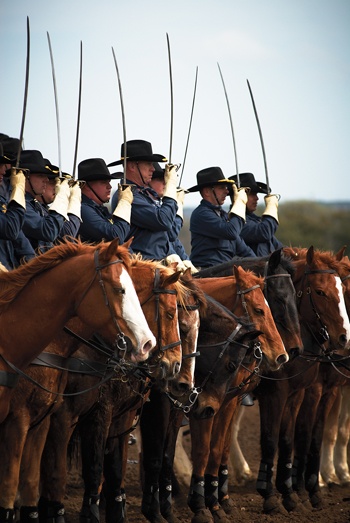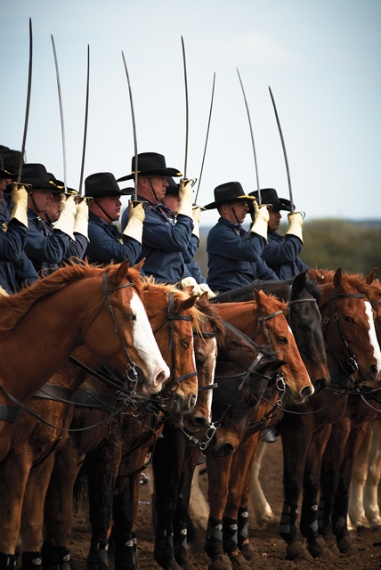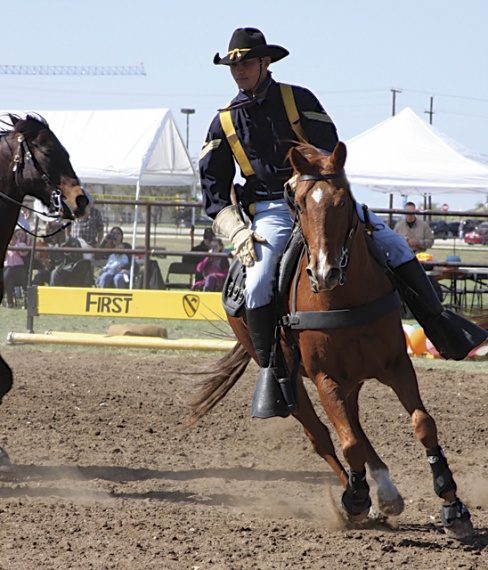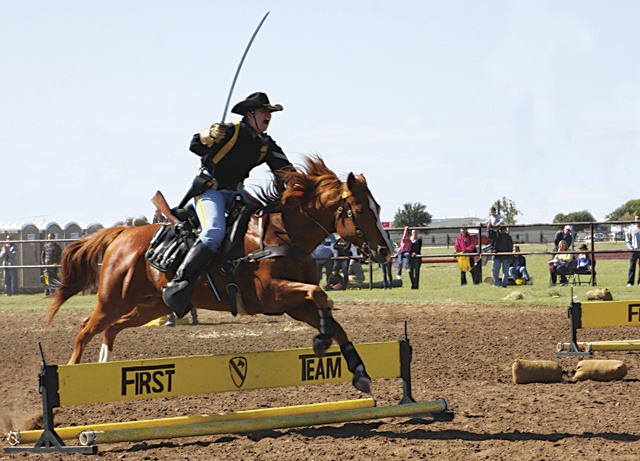Generations have passed since warrior and steed confronted terrain and tyrants under the Stars and Stripes. Horse-mounted troops were no match against the machinery and weaponry that began to dominate the battlefield in the past century, and so the U.S. Army did the prudent thing and put the cavalry out to pasture.
That is, it took the noble beasts out of harm’s way. But the Army holds firm to its traditions and has kept a spot in its heart and on some of its posts for the cavalry to thrive. That is why whinnying and the rattle of sabers emerge from the past once a week at Fort Hood in Killeen for a demonstration of centuries-old horsemanship skills.
The Horse Cavalry Detachment of the 1st Cavalry Division, based at Fort Hood, is one of seven horse detachments on active duty in the Army. (The others are at Fort Carson, Colorado; Fort Huachuca, Arizona; Fort Irwin, California; Joint Base Myer-Henderson Hall, Virginia; Fort Sill, Oklahoma; and Fort Riley, Kansas.) Since its inception in 1972 as a special ceremonial unit, the 33 troopers and one officer permanently assigned to the detachment have striven for authenticity. Uniforms are 1870-era authentic dark blue shirts, sky blue trousers secured by bright yellow suspenders, black felt Stetsons and 19-inch black cavalry boots.
The 37 horses—all geldings—are chosen to fit standards imposed a century ago. They are dark in color, of medium height, and show a minimum of white markings. They are outfitted with replica McClellan saddles, designed by career Army officer George B. McClellan and adopted by the Army in 1859. The replicas are made by troopers in the leather shop maintained at the cavalry barn on-post.
The Fort Hood unit’s close-order mounted drills—performed at a walk, trot and gallop—are taken directly from the 1874 Cavalry Drill and Tactics Manual. “We work hard on developing military posture in the saddle,” says Spc. Curtis Dethample. “When we ride, there should be an imaginary straight line that runs from our ears through our shoulders, hips and heels. No slouching in the saddle allowed.”
No slouching under the saddle, either. New horses go through training that can take up to a year.
“Not all horses adapt well to cavalry training,” says Staff Sgt. Michael Hatfield. “They have to be athletic to complete the drill maneuvers and calm during noisy parades or when firearms are discharged from their backs in demonstrations.”
Soldiers volunteer for the unit and must be recommended by their superiors. To qualify, they must first be able to jump aboard a 16-hand horse—64 inches—bareback from the ground—no small feat. That accomplished, they take a written test and go through many hours of training in horse anatomy, firearms use and close-order drills before they are assigned full time to the horse detachment.
Each mounted trooper carries a Colt revolver, a Springfield carbine and an 1860 model light cavalry saber and is expected to hit targets with each weapon at a full gallop.
Fort Hood’s mounted cavalry continues the proud traditions forged by the 1st Texas Cavalry Regiment, formed in 1862 to serve the federal army in the Civil War. But cavalry forces in the American military date all the way back to the Revolution, when Henry “Light Horse Harry” Lee III, father of Robert E. Lee, led mounted soldiers against the British.
After the Revolution, 50 years passed before cavalry units became part of the regular army again. Congress approved the nation’s first true cavalry divisions in 1833 for the purpose of subduing Native American tribes, but the American cavalry came into its own during the Civil War. Jefferson Davis recognized the potential of mounted forces, and the South drew its mounts from the many superb bloodlines in Kentucky, Virginia and North Carolina.
The most famous cavalry regiment in the Army was the 1st Volunteer Cavalry, better known as the Rough Riders, recruited by Theodore Roosevelt in 1898 during the Spanish-American War and trained in San Antonio. And long before he was a leader in World War II, George S. Patton Jr. joined Brig. Gen. John J. Pershing’s horse-mounted expedition against Pancho Villa in 1916.
The training of cavalry troops in the 20th century remained mostly unchanged until just before World War II. A few mounted units saw action in France, but the mechanization of the cavalry had already begun.
By 1940, the horse had been left behind, replaced by jeeps, trucks, tanks and aircraft. The final mounted charge took place on January 16, 1942, when the 26th Cavalry drove back Japanese tanks in the Philippines.
At Fort Hood, the Horse Cavalry Detachment rides on. Demonstrations, which take place on Thursday mornings at the cavalry barn, open with cannon fire. When the smoke clears, the troopers ride through intricate patterns and negotiate jumps accompanied by high-spirited shouts from the riders, who expertly slay balloons and stuffed burlap targets on the demonstration field.
The detachment is a recruiting tool for the Army. It travels throughout the United States, appearing in military ceremonies, parades, rodeos and public demonstrations. The troopers have ridden in the inaugural parades of two presidents and in 10 Tournament of Roses parades.
“This is by far the best job in the Army,” Dethample says.
——————–
Martha Deeringer, frequent contributor





